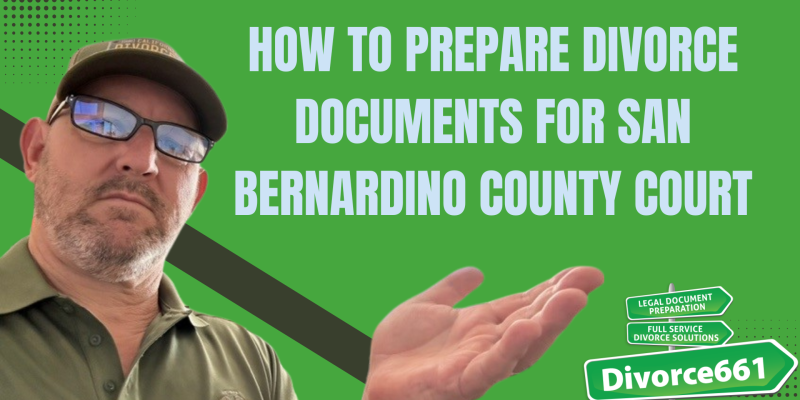How to Prepare Divorce Documents for San Bernardino County Court
I’m Tim Blankenship of Divorce661. In this guide I’ll walk you through exactly how to prepare divorce paperwork for San Bernardino County so your case isn’t delayed or rejected. I explain the required forms, the mandatory disclosures, how service works, what goes into your judgment package, common mistakes to avoid, and what we do to help clients get their divorces approved quickly.
Overview: The process in a nutshell
Filing for divorce in San Bernardino County follows a predictable sequence. Get these steps right and you avoid the most common cause of delays: court rejections for missing or inconsistent paperwork.
- File the initial paperwork (Petition, Summons, and UCCJEA if you have children).
- Legally serve your spouse.
- Complete and exchange Preliminary Financial Disclosures (mandatory).
- Prepare and submit your Judgment package (includes Marital Settlement Agreement if applicable).
Step 1 — Initial filings: Petition, Summons, and UCCJEA
The very first documents are the Petition and Summons. If you and your spouse have children under 18, you must also complete the UCCJEA (Uniform Child Custody Jurisdiction and Enforcement Act) form. These establish the court’s jurisdiction and the basic requests in your case (dissolution, property division, custody, support, etc.).
Important tip: San Bernardino accepts eFile for family law documents, so you often don’t need to visit the courthouse in person. However, the forms must be filled out completely and accurately before you submit.
Step 2 — Service: Getting the papers to your spouse
After filing, your spouse must be legally served with the court papers. Service must follow California rules (personal service by a non-party over age 18, or a court-approved method such as substituted service or service by mail when appropriate). The court will not proceed until service is complete and proof of service is filed.
Step 3 — Preliminary Financial Disclosures (mandatory)
San Bernardino courts require both parties to exchange preliminary financial disclosures before the court will review or finalize resolutions. These are not optional.
The required disclosures include:
- Schedule of Assets and Debts (FL-142): A full accounting of community and separate property, liabilities, retirement accounts, real estate, and other assets.
- Income and Expense Declaration (FL-150): Monthly income, deductions, and expenses used to calculate temporary support or to inform negotiations.
Complete these forms carefully. Omissions, wrong numbers, or inconsistencies between forms are the most frequent reasons for court rejections later on.
Step 4 — The Judgment package: what the court expects
The last major step is preparing your judgment package for submission once the parties have reached agreement or completed required processes. This package typically includes:
- Marital Settlement Agreement (if you have one)
- Final Judgment forms
- All required attachments and disclosures
- Any custody agreements or child support worksheets
San Bernardino courts are strict about completeness and internal consistency. If numbers, names, or dates don’t match across forms, the court will reject the package and send it back for corrections.
San Bernardino courts are strict. If anything is missing or filled out incorrectly, your case will be rejected.
Common mistakes that lead to rejection (and how to avoid them)
- Inconsistent financial numbers across the Income and Expense Declaration, Schedule of Assets and Debts, and settlement agreement — cross-check all figures.
- Missing signatures or notary where required — always sign and date every form that requests it.
- Using the wrong county-specific forms or outdated versions — always download the current forms and local mandatory attachments for San Bernardino County.
- Leaving blanks instead of writing “N/A” or “None” — courts interpret blanks as incomplete.
- Poorly executed proof of service — follow service rules exactly and file proof promptly.
- Failing to exchange Preliminary Financial Disclosures before trying to submit the judgment package — disclosures are required prior to court review.
A real example: how careful review speeds approval
We recently helped a San Bernardino couple who prepared their own paperwork and submitted a judgment package that the court rejected due to inconsistencies. We reviewed every form, corrected the discrepancies, completed missing attachments, and refiled everything electronically. Because the revised package was complete and consistent, the court approved their divorce within a few weeks.
Practical checklist before you eFile
- Confirm you have the correct, current San Bernardino forms and attachments.
- Complete Petition, Summons, and UCCJEA (if kids).
- Arrange legal service and prepare proof of service.
- Prepare and exchange Schedule of Assets and Debts and Income and Expense Declaration.
- Draft Marital Settlement Agreement (if applicable) and assemble the full Judgment package.
- Cross-check names, dates, and numbers for consistency across all documents.
- Sign and notarize where required, then eFile through the court’s system.
How Divorce661 helps
At Divorce661 we specialize in preparing and filing complete, court-ready divorce paperwork for San Bernardino County. Our service includes:
- Flat-fee pricing for predictable costs
- 100% remote service with eFile submission
- Filing, service coordination, disclosures, and judgment preparation handled start-to-finish
- Attention to San Bernardino’s strict local requirements to prevent rejections
If you’d like help preparing your divorce documents in San Bernardino County, visit Divorce661.com to schedule a free consultation. We’ll review your situation, prepare the forms correctly the first time, and keep your case moving.
Final thoughts
Filing for divorce can be stressful, but most delays come from paperwork problems that are avoidable. Follow the sequence: file the Petition and Summons (and UCCJEA if needed), serve your spouse correctly, exchange Preliminary Financial Disclosures, and prepare a consistent, complete Judgment package. Cross-check everything before eFiling, and if you’re unsure, get help—fixing mistakes later costs time and money.
For a free consultation and help with San Bernardino County divorce filings, go to Divorce661.com.

